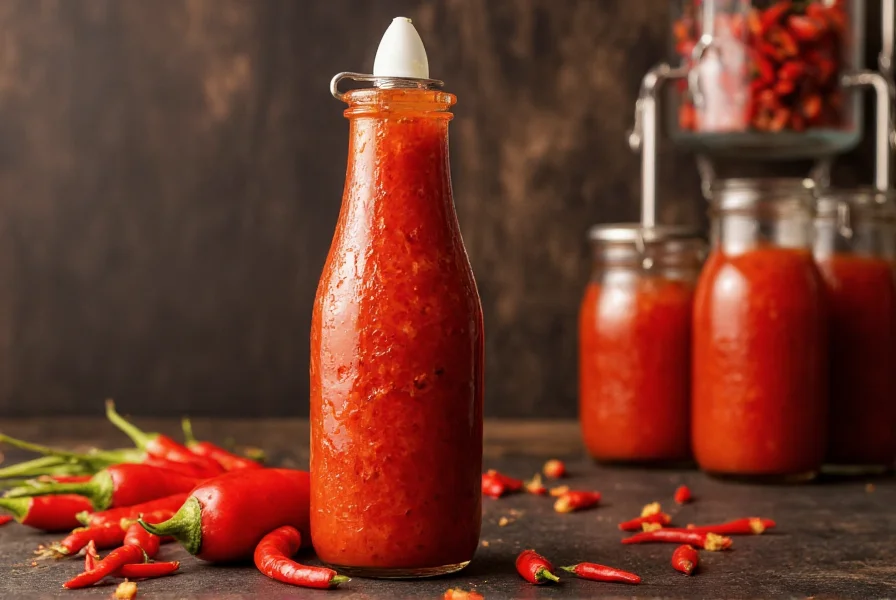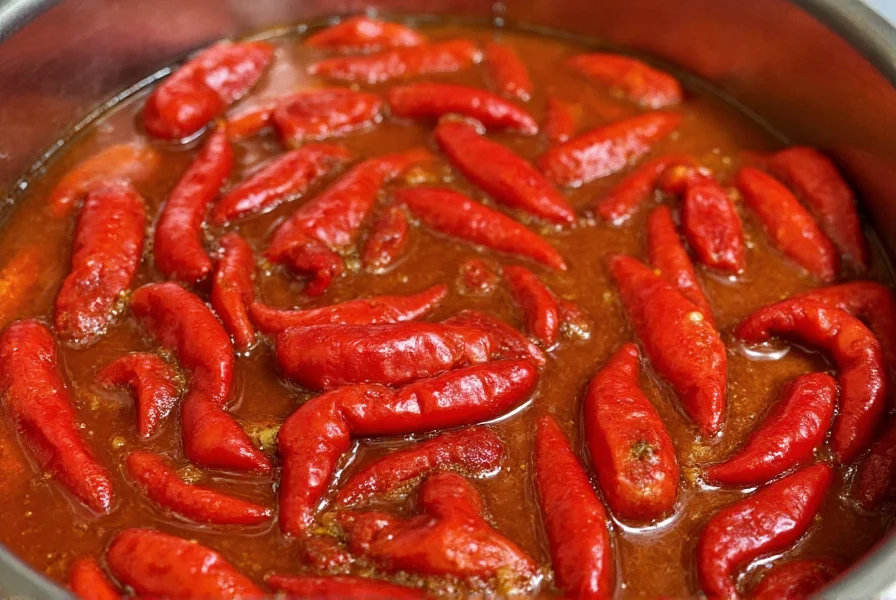Fermented chili sauce represents one of the most sophisticated forms of hot sauce production, combining ancient preservation techniques with modern culinary applications. Unlike vinegar-based hot sauces that rely on acidification for preservation, fermented varieties develop their distinctive tangy, complex flavor profile through natural microbial activity. This biological process transforms simple ingredients into a multidimensional condiment prized by chefs and home cooks alike.
The Science Behind Chili Fermentation
Lactic acid fermentation occurs when naturally occurring bacteria convert sugars in chili peppers into lactic acid. This process requires three essential components: chili peppers, salt, and time. The salt concentration (typically 2-3%) creates an environment where beneficial Lactobacillus bacteria thrive while inhibiting harmful microorganisms. During the fermentation period—which ranges from two weeks to several months—the bacteria break down carbohydrates, producing lactic acid that lowers the pH and creates that characteristic tang.
Temperature plays a crucial role in the fermentation process. Ideal conditions (65-75°F or 18-24°C) allow for steady microbial activity without encouraging unwanted bacteria. Many traditional fermented chili sauce recipes incorporate additional ingredients like garlic, ginger, or fruit that contribute both flavor complexity and additional fermentable sugars.

Historical Significance of Fermented Chili Sauces
Fermentation represents one of humanity's oldest food preservation methods, with evidence dating back thousands of years. In regions where chili peppers became staple crops after their introduction from the Americas, fermentation provided an effective way to preserve the harvest through lean seasons. Traditional Asian fermented chili sauces like Korean gochujang and Chinese doubanjiang demonstrate sophisticated applications of this technique, while Latin American cultures developed their own variations using native chili varieties.
The distinction between fermented and vinegar-based hot sauces became particularly pronounced as global trade expanded. Regions without ready access to vinegar developed fermentation as their primary preservation method, resulting in distinctive regional variations that continue to influence contemporary culinary practices.
Benefits of Fermentation for Chili Sauces
Fermentation offers several advantages over quick vinegar-based preparations:
- Flavor complexity - The enzymatic breakdown of compounds creates hundreds of new flavor molecules
- Natural preservation - Lactic acid creates an inhospitable environment for pathogens
- Digestive benefits - Contains live probiotics that support gut health
- Enhanced nutrient availability - Breaks down anti-nutrients and increases vitamin content
- Reduced need for additives - Natural preservation eliminates requirement for artificial preservatives
| Characteristic | Fermented Chili Sauce | Vinegar-Based Hot Sauce |
|---|---|---|
| Production Time | 2 weeks to 6 months | Immediate |
| Flavor Development | Complex, evolving notes | Sharp, one-dimensional |
| Preservation Method | Natural lactic acid | Added vinegar |
| Probiotic Content | Present (if unpasteurized) | Absent |
| Shelf Stability | 6-12 months refrigerated | 1-2 years unrefrigerated |
Traditional Varieties of Fermented Chili Sauce
Across culinary traditions, distinctive fermented chili sauces have emerged:
- Sriracha (Traditional) - The original Thai sriracha differs significantly from commercial versions, featuring a more complex fermented profile with garlic-forward notes
- Gochujang - Korean fermented chili paste combining chili powder, glutinous rice, and fermented soybeans
- Doubanjiang - Chinese broad bean and chili paste fermented with salt and麹 (fermented grain)
- Nuoc Mam Cham - Vietnamese fish sauce-based fermented chili condiment
- Hawaij - Yemeni fermented chili sauce with spices like cumin and turmeric
Each regional variation reflects local ingredients, climate conditions, and cultural preferences, resulting in distinctive flavor profiles that have influenced global cuisine.
Creating Homemade Fermented Chili Sauce
Producing quality fermented chili sauce at home requires attention to detail but minimal equipment. The basic process involves:
- Preparing fresh chili peppers (500g), removing stems but keeping seeds for heat
- Mixing with non-iodized salt (10-15g) and optional flavor enhancers like garlic (100g)
- Packing into fermentation vessel, ensuring peppers remain submerged
- Allowing fermentation at room temperature for 1-4 weeks, burping daily
- Blending with vinegar (optional for shelf stability) and straining
- Bottling in sterilized containers
Successful fermentation depends on maintaining anaerobic conditions during the initial stages. Many home fermenters use weights to keep ingredients submerged below the brine line. The development of bubbles, slight cloudiness, and a pleasant sour aroma indicate healthy fermentation. Unpleasant odors, mold (other than kahm yeast which is harmless), or slimy texture signal potential problems.

Culinary Applications and Pairing
Fermented chili sauce's complex flavor profile makes it exceptionally versatile in cooking. Unlike vinegar-based hot sauces that primarily add heat and acidity, fermented varieties contribute umami depth and subtle sweetness that complement rather than dominate dishes.
Chefs often use fermented chili sauce as:
- A base for complex sauces and marinades
- A finishing touch to enhance umami in soups and stews
- A component in dressings where its natural viscosity provides emulsification
- A flavor enhancer in vegetarian and vegan cooking to mimic meaty notes
- A dipping sauce component that pairs well with both delicate and robust flavors
When pairing with foods, consider the specific chili variety used in fermentation. Fruit-forward sauces made with habaneros complement tropical flavors, while earthy sauces from fermented guajillo or ancho peppers pair well with roasted meats and root vegetables.
Safety Considerations in Fermentation
While lactic acid fermentation is generally safe, proper technique prevents potential issues:
- Maintain proper salt concentration (2-3% by weight) to inhibit harmful bacteria
- Ensure complete submersion of ingredients to prevent mold growth
- Use clean, non-reactive containers (glass or food-grade plastic)
- Avoid metal containers which can react with acids
- Monitor for signs of spoilage: foul odors, slimy texture, or visible mold beyond surface kahm yeast
Properly fermented chili sauce should have a pleasantly sour aroma, vibrant color, and clear brine. The pH should measure below 4.6, creating an environment inhospitable to dangerous pathogens. For extended shelf life, refrigeration after fermentation slows further microbial activity while preserving probiotic benefits.
Understanding Commercial Fermented Chili Sauce Products
When purchasing fermented chili sauce, consumers should note several important factors:
- Refrigeration requirement - Truly raw, unpasteurized fermented sauces require refrigeration
- Ingredient list - Authentic fermented sauces list only peppers, salt, and sometimes additional vegetables
- Fermentation time - Quality producers often specify minimum fermentation periods
- Probiotic claims - Only unpasteurized products contain live cultures
Many commercial products labeled as "fermented" actually use vinegar with fermented ingredients added for flavor. True fermented chili sauce develops its acidity naturally through the fermentation process rather than having acid added afterward.
Conclusion
Fermented chili sauce represents the pinnacle of chili condiment craftsmanship, transforming simple ingredients through biological processes into complex flavor experiences. Its growing popularity reflects both culinary sophistication and renewed interest in traditional food preservation methods. Whether produced commercially following time-honored techniques or crafted at home with basic equipment, properly made fermented chili sauce offers distinctive flavor depth, natural preservation, and potential digestive benefits that distinguish it from vinegar-based alternatives. As consumers become more discerning about food production methods, understanding the nuances of authentic fermented chili sauce helps appreciate this ancient culinary art in its modern context.
Frequently Asked Questions
How long does homemade fermented chili sauce last?
Properly fermented and refrigerated chili sauce typically maintains quality for 6-12 months. The high acidity and low pH created during fermentation provide natural preservation. Signs of spoilage include mold growth (beyond surface kahm yeast), unpleasant odors, or significant texture changes. Always use clean utensils when handling to prevent contamination.
Can I make fermented chili sauce without salt?
Traditional lactic acid fermentation requires salt (typically 2-3% by weight) to create the proper environment for beneficial bacteria while inhibiting pathogens. Salt-free fermentation significantly increases safety risks and typically results in spoilage rather than proper fermentation. Some modern techniques use whey or other starters, but these still require careful monitoring and aren't recommended for beginners.
Why does my fermented chili sauce smell alcoholic?
A slight alcoholic aroma during fermentation indicates yeast activity alongside bacterial fermentation, which is normal in many traditional processes. This usually mellowes as fermentation progresses. However, a strong alcoholic smell throughout fermentation may indicate improper conditions. Ensure proper salt concentration, temperature control (65-75°F), and complete submersion of ingredients to maintain ideal lactic acid bacteria dominance.
Does fermented chili sauce contain probiotics?
Raw, unpasteurized fermented chili sauce contains live probiotic bacteria, primarily Lactobacillus species. However, most commercial products are pasteurized for shelf stability, which destroys these beneficial microorganisms. To obtain probiotic benefits, seek refrigerated products labeled "raw," "unpasteurized," or "contains live cultures," and consume them without cooking, as heat destroys the probiotics.
How can I adjust the heat level in fermented chili sauce?
Heat level is primarily determined by chili variety and seed inclusion. For milder sauce, remove seeds and membranes before fermentation. For hotter results, include more seeds or use hotter pepper varieties. Note that fermentation slightly mellows heat over time, so sauces often become less intense during the process. You can also blend hot peppers with milder varieties like bell peppers to achieve your desired heat level while maintaining fermentation capability.











 浙公网安备
33010002000092号
浙公网安备
33010002000092号 浙B2-20120091-4
浙B2-20120091-4